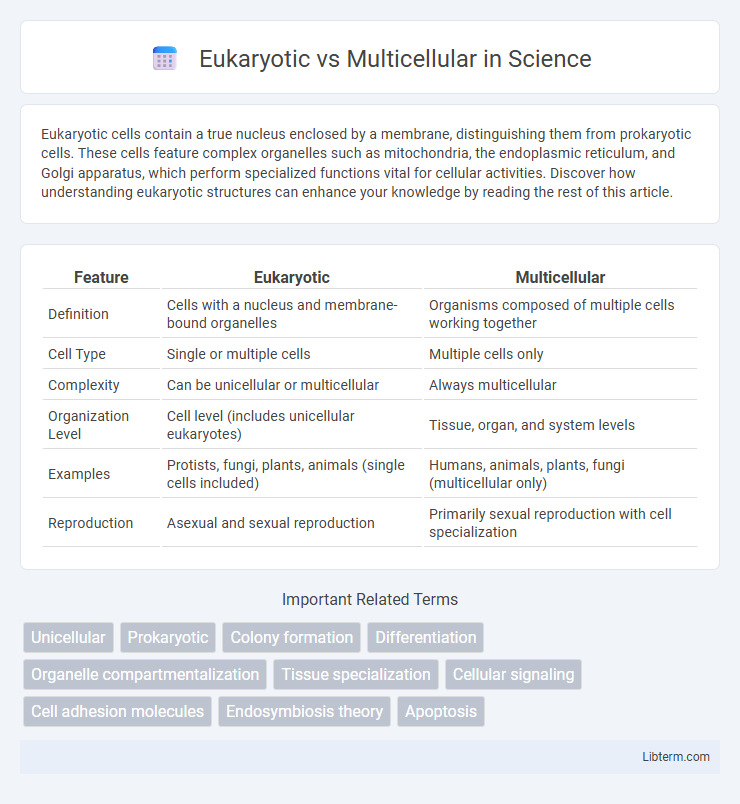Eukaryotic cells contain a true nucleus enclosed by a membrane, distinguishing them from prokaryotic cells. These cells feature complex organelles such as mitochondria, the endoplasmic reticulum, and Golgi apparatus, which perform specialized functions vital for cellular activities. Discover how understanding eukaryotic structures can enhance your knowledge by reading the rest of this article.
Table of Comparison
| Feature | Eukaryotic | Multicellular |
|---|---|---|
| Definition | Cells with a nucleus and membrane-bound organelles | Organisms composed of multiple cells working together |
| Cell Type | Single or multiple cells | Multiple cells only |
| Complexity | Can be unicellular or multicellular | Always multicellular |
| Organization Level | Cell level (includes unicellular eukaryotes) | Tissue, organ, and system levels |
| Examples | Protists, fungi, plants, animals (single cells included) | Humans, animals, plants, fungi (multicellular only) |
| Reproduction | Asexual and sexual reproduction | Primarily sexual reproduction with cell specialization |
Introduction to Eukaryotic and Multicellular Concepts
Eukaryotic cells possess membrane-bound organelles and a defined nucleus, distinguishing them from prokaryotic cells primarily through their complex internal structure. Multicellular organisms consist of multiple eukaryotic cells that specialize and coordinate functions to maintain life processes, enhancing biological complexity and adaptability. The introduction to these concepts emphasizes cellular organization and the evolutionary significance of cell specialization in multicellularity.
Defining Eukaryotic Cells
Eukaryotic cells are defined by the presence of membrane-bound organelles, including a nucleus that houses genetic material, distinguishing them from prokaryotic cells. These cells typically contain complex structures like mitochondria, endoplasmic reticulum, and Golgi apparatus, which enable compartmentalized cellular functions. Multicellularity refers to organisms composed of multiple eukaryotic cells working together, but the defining feature of eukaryotic cells lies in their structural complexity and intracellular organization.
What Does Multicellularity Mean?
Multicellularity refers to the organization of an organism composed of multiple cells that work collaboratively, enabling specialization and greater complexity beyond single-celled eukaryotes. In eukaryotic multicellular organisms, cells differentiate into various types with distinct functions, supporting tissue and organ formation. This cellular cooperation and division of labor is the defining characteristic distinguishing multicellular life forms from unicellular eukaryotes.
Key Differences Between Eukaryotic and Multicellular Organisms
Eukaryotic organisms possess cells with membrane-bound organelles and a defined nucleus, while multicellular organisms consist of multiple eukaryotic or prokaryotic cells working collectively. The key difference lies in that eukaryotic refers to cell type, characterized by complex cellular structures, whereas multicellularity pertains to the organismal level, involving cell specialization and differentiation. Eukaryotes can be unicellular or multicellular, but multicellular organisms rely on cellular cooperation and tissue formation for biological functions.
Examples of Eukaryotic Organisms
Eukaryotic organisms include a wide range of life forms such as animals, plants, fungi, and protists, all characterized by cells containing a nucleus and membrane-bound organelles. Examples of multicellular eukaryotes include humans (Homo sapiens), oak trees (Quercus species), and mushrooms (Agaricomycetes), while unicellular eukaryotes like amoebae and paramecia also fall within this category. These examples illustrate the diversity of eukaryotic life, spanning both single-celled and complex multicellular organisms.
Evolution of Multicellularity
Multicellularity evolved independently in several eukaryotic lineages, representing a major transition in the complexity of life. This evolutionary step involved the specialization and cooperation of cells, allowing organisms like plants, animals, and fungi to develop complex structures and functions. Genetic innovations such as cell adhesion, communication, and differentiation were crucial in enabling eukaryotic cells to form multicellular organisms.
Cellular Organization in Eukaryotes vs Multicellular Life
Eukaryotic cells exhibit complex cellular organization with membrane-bound organelles such as the nucleus, mitochondria, and endoplasmic reticulum, enabling specialized functions within a single cell. Multicellular life consists of numerous eukaryotic cells that differentiate and organize into tissues, organs, and systems to perform coordinated functions beyond the capability of individual cells. Cellular communication and division of labor in multicellular organisms enhance biological complexity and organismal functionality compared to unicellular eukaryotes.
Advantages of Being Eukaryotic
Eukaryotic cells possess membrane-bound organelles such as the nucleus, mitochondria, and endoplasmic reticulum, enabling efficient compartmentalization and specialization of cellular functions. This cellular complexity allows for greater metabolic efficiency, enhanced genetic regulation, and the ability to perform advanced processes like cellular respiration and protein synthesis. Consequently, the eukaryotic cellular organization provides a significant advantage in supporting diverse life forms, including both unicellular and multicellular organisms.
Benefits and Challenges of Multicellularity
Multicellularity offers benefits such as cellular specialization, enabling complex organisms to perform diverse functions more efficiently, and enhanced size that provides protection against predators and environmental fluctuations. Challenges include the requirement for intricate communication and coordination systems among cells to maintain homeostasis, and the increased energy demand to support more extensive biological processes. Multicellular organisms also face difficulties in cellular differentiation control, which can lead to issues like cancer, highlighting the complexity of maintaining organismal integrity.
Eukaryotic Unicellular vs Multicellular Species
Eukaryotic organisms exhibit both unicellular and multicellular forms, with unicellular eukaryotes like Amoeba and Paramecium thriving independently, while multicellular species such as humans and plants consist of complex cell differentiation and tissue specialization. Unicellular eukaryotes perform all life processes within a single cell, relying on organelles like the nucleus and mitochondria for metabolic functions, whereas multicellular eukaryotes benefit from cellular cooperation and division of labor. The evolutionary transition from unicellularity to multicellularity enabled increased organismal complexity and adaptability in eukaryotic lineages.
Eukaryotic Infographic

 libterm.com
libterm.com